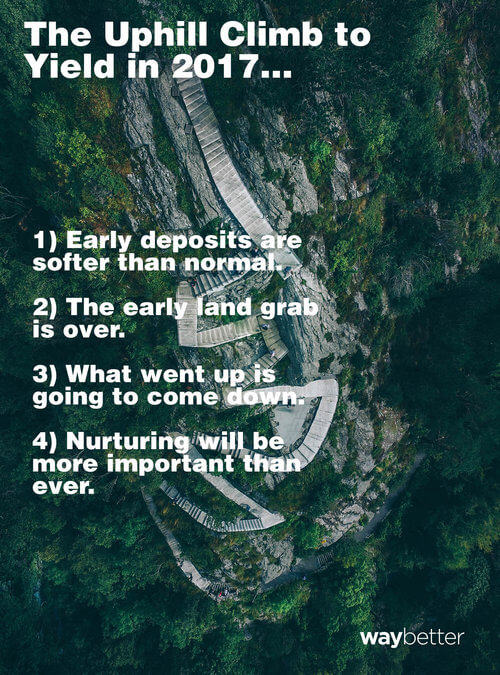Yield season invariably brings large amounts—and particular strains—of stress to admissions and marketing offices around the country. Some of you bear the burden of building a first-year class that nudges your institution up in regional or national rankings. Others of you—facing unrelenting demographic trends and fierce competition in the marketplace—simply need to bring in a class large enough to fund your school’s operating budget.
Regardless of where you and your school fall on this spectrum, the process of figuring out who’s coming and who isn’t is not for the faint of heart (or weak of stomach). This season, owing largely to the effects of PPY, you can expect things to be even more challenging.
We’re basing that assessment—and the following insights—on info we’ve gathered from our clients who represent a broad swath of institutions and who are diverse across a number of metrics (size, selectivity, geography, etc.).
1) Early deposits will prove to be softer than normal.
Schools that admitted/awarded students who took advantage of PPY did bring in more deposits sooner than they otherwise would have. They were many students’ first offer, and being first matters…right up until it doesn’t.
Many students who deposited early will be susceptible to offers from more desirable/selective schools that didn’t get out early enough in awarding. These schools, having been beaten to the punch, will have to “reach down” (for lack of a better phrase), and may tempt students who’ve already committed elsewhere.
This will of course create a ripple effect, making for a crazy stretch run. (We’re talking last 3 laps of the Daytona 500 here.)
2) The early land grab is over.
If you were out early with awards, you lassoed a willingness in the marketplace to forego choice in favor of a sure thing. But that willingness to commit early wanes as time passes. If you didn’t grab students early, you’re not going to get them early now.
3) What went up is going to come down.
Many schools are up in deposits from this point last year. But they’re not all going to end up in deposits, so don’t treat your velocity as indicative of a sustainable trend.
It’s imperative that you figure out from your remaining admits who is coming and who might be coming, and reach out to them accordingly.
4) Nurture needs to trump nature.
Depositing early is absolutely a strong indicator of real intent and real interest. But bear in mind that doubt and second-guessing are functions of time—and the more time, the more chance for changed minds. It’s human nature, especially when dealing with 18-year-olds.
Your deposits—especially the early ones—need more sustained nurturing than you’ve done in the past. In fact, we recommend treating your early deposits as you would your admitted pool. Keep the messaging coming. Be helpful and responsive in everything you do.
